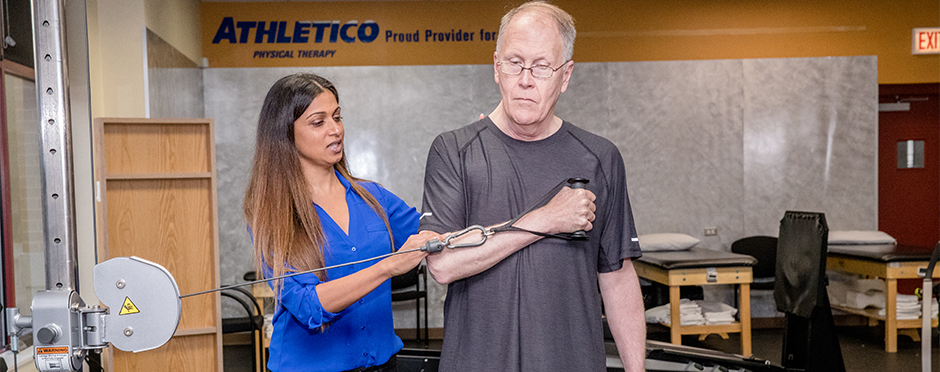
What Does Physical Therapy Look Like After A Stroke?
Leave a CommentDuring one year in the United States, 795,000 people will have a stroke, or cerebrovascular accident (CVA)1. Of these, 610,000 will be first-time CVA1. This is obviously a large number, and chances are you know someone who has experienced, or will know someone who will experience a CVA.
Following a stroke, individuals often have deficits on one side of their body. These deficits include weakness, numbness, incoordination, stiffness, and pain. The extent and location of these deficits depends upon the severity and part of the brain of an individual’s CVA. In addition to extensive medical care, individuals who suffer a stroke will need rehabilitation, including physical therapy. If you, or someone you know has suffered a stroke, you might be wondering what a physical therapy plan of care will entail.
Post-CVA rehabilitation is focused on returning an individual to their prior level of day-to-day function or make accommodations as best as possible at their new level of function. Physical therapy is going to be guided by the severity of deficits resulting from the CVA. This blog will focus on outpatient therapy. Individuals with more severe deficits following a stroke will most likely spend time at an inpatient facility for their rehabilitation needs.
Involved Limb(s) Mobility And Strength
Typically, one side of the persons’ body is going to be weaker. This is referred to as the involved side. Physical therapy will focus on specific exercises to strengthen this side. Lifting weights, stretching bands, even pushing down on the handle of a walker builds up necessary strength in an involved arm. Likewise, squatting, pushing a leg press, or even standing with therapist assistance builds up necessary strength for an involved leg.
Balance Drills
Maintaining balance can be tough following a stroke. A combination of poor sensation and weakness can make what initially was an easy task, like sitting at the edge of a chair, a risky position for individuals with CVA. Physical therapy will challenge individuals’ sense of balance to improve this skill. Tasks in different positions such as sitting, standing, and walking, can improve with repetition.
Gait Re-Training
Walking can be a difficult task for individuals who have had a CVA. The combination of poor strength and poor balance makes walking strenuous and unstable. Left unaddressed, this could lead to falls, or the individual just avoiding walking altogether. Physical therapy can use many different methods of gait re-training to improve safety and efficiency while walking. A physical therapist may give specific walking tasks, use hands-on assistance with a belt, or even use parallel bars for sturdy support. Walking, or locomotion in general, is often a large percentage of overall physical therapy treatment.
Coordination Tasks
Completing two or more motions at once requires coordination. Consider this task; walking while holding a laundry basket and reaching to grab a bedroom door. That task alone requires all the previous mentioned goals of therapy. The strength to hold a laundry basket, good balance to hold the basket while reaching out one hand, and of course the ability to walk. Physical therapy will gradually increase the complexity of interventions to challenge an individual’s coordination.
Occupational Therapy And Speech Therapy
Physical therapy is not the only rehabilitation an individual will need. Occupational therapy provides extensive rehabilitation focused on tasks such as grooming, feeding, dressing, and other fine-motor skills. Speech therapy focuses on communication, cognition, and language skills if any of these are affected. Because we combine physical motion, self-care tasks, and communication on a daily basis, rehabilitation will also combine these functions. The rehabilitation team will collaborate care between these disciplines.
Ultimately, the physical therapy program an individual with CVA completes will be customized to their needs. Physical therapists, as well as all rehabilitation professionals, work with individuals who have suffered a stroke and their families along with other healthcare providers to optimize quality of life. Athletico physical therapists are well-trained in the rehabilitation needs of individuals who have had a stroke. Our physical therapists can deliver optimized physical therapy programs to improve daily function for individuals with CVA. To learn if physical therapy is right for you or your loved one, schedule a free assessment with an Athletico location near you. Free Assessments are available in-clinic and virtually through our Telehealth services.
*Per federal guidelines, beneficiaries of plans such as Medicare, Medicaid, Tricare, VHA and other federally funded plans are not eligible for free assessments.
The Athletico blog is an educational resource written by Athletico employees. Athletico bloggers are licensed professionals who abide by the code of ethics outlined by their respective professional associations. The content published in blog posts represents the opinion of the individual author based on their expertise and experience. The content provided in this blog is for informational purposes only, does not constitute medical advice and should not be relied on for making personal health decisions.
References:
1.https://www.cdc.gov/stroke/facts.htm#:~:text=Every%20year%2C%20more%20than%20795%2C000,
are%20first%20or%20new%20strokes.&text=About%20185%2C000%20strokes%E2%80%94nearly%201,
have%20had%20a%20previous%20stroke.
